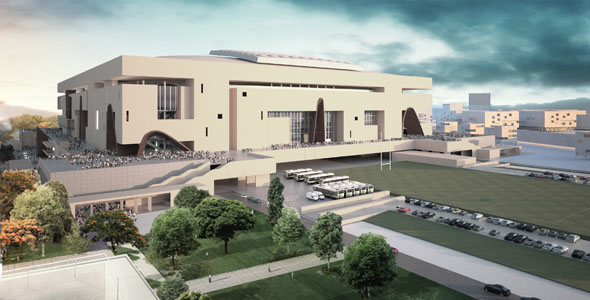Kicking off! The Future of Rugby Stadia – By Populous’ Richard Breslin and François Clément
March 19, 2015
With the 2015 Six Nations championship entering its final weekend, we have seen some exciting rugby and some great occasions.
As ever, a huge part of this success is based on the atmosphere that is created between these close neighbours, with their historic sporting rivalries. But in an age where television is king, what is it about the new generation of rugby stadia that is continuing to draw huge crowds and re-energising local areas?
My colleague François Clément considers this and questions whether the future of rugby stadia around the world be about more than just rugby?
In the run-up to the first match of this year’s Six Nations championship, many newspapers focussed on the England team’s determination not to be intimidated by the incredible atmosphere at Wales’ Millennium Stadium in Cardiff, which was thought to play a role in their demoralising 30-points to 3 defeat to Wales in last year’s championship.
“You have to experience an atmosphere like that, live through it, play through it and learn from it. It defines you as a player,” England coach Graham Rowntree told the Guardian newspaper.

In the past, rugby stadia were not particularly known for their comforts. This was the home of the strong men, where the fans were often larger than those on the pitch.
But times have changed, and families have become an important fixture in the rugby-fan community.
Since 1995, and the creation of professional leagues in the main European rugby nations, the importance of the entertainment side of the game has grown dramatically, with TV rights for national and international competitions being increased every time they are negotiated.
As more games are televised, and shown to a wider audience, international clubs and their owners are recognising the need to improve their venues, and their offering to fans and the local community.
Rather than simply being the place where games are played for a couple of hours on a Sunday afternoon, the modern stadium provides the background for the whole fan experience; from the build-up in the week before, to the match-day broadcast and the camera’s ability to show the game (and stadium) from every angle at every speed.
The live experience of these stadia on match day, from the moment fans arrive in the morning and socialise in the fan zones, to celebrating/commiserating after the match in specially designed areas, augments the in situ fan experience and can all be shared around the world.
Although the teams and crowds may leave after the match, far from being empty shells during the rest of the week, many stadiums are moving from the outskirts of towns to form a central hub of activity within the city centre.
When I joined the Populous team in 2006, to work on the design of the Aviva Stadium in Dublin, Ireland, the revolution of rugby stadia was already well underway.
In fact, the Aviva Stadium was an evolution of Cardiff’s Millennium Stadium, completed in 1999, incorporating many design features to ensure the future economic sustainability of the stadium and its local area.


